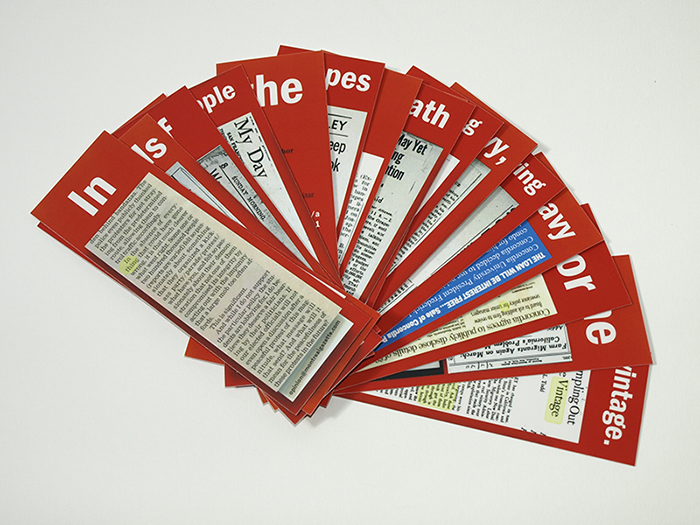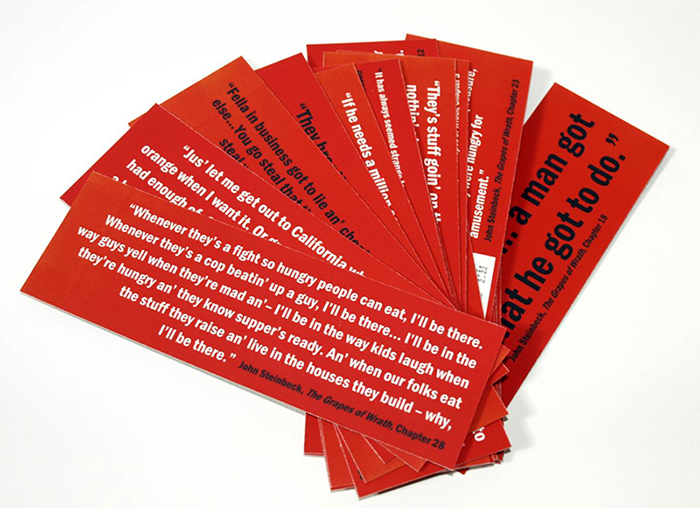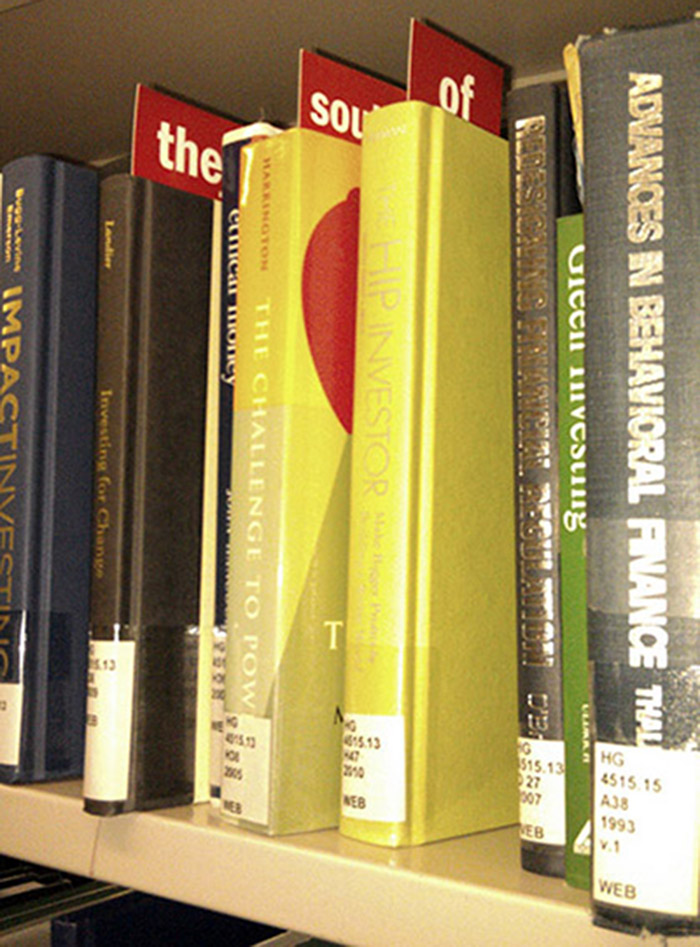
Carolyn Weisnagel
3rd Year, Art Education Specialization
Red Book Marks – “In the souls of the people the grapes of wrath are growing heavy, growing heavy for the vintage”
Red Bookmarks was an exploration of institutional critique in the context of the then ongoing student protests in Quebec. The project silently dialogued with the library’s architectural space as a place for gathering and providing a vast world of knowledge, history, and stories.
Books provide worlds of reflection within their interactive, quiet, and safe space. They ignite a process that is relational and immediate as well as simultaneously timeless and fixed. The epic storytelling, class struggle, and rich characters of John Steinbeck’s The Grapes of Wrath have strongly inspired my art practice. The novel captures the strength and perseverance of people in times of struggle, which resonates with my interest in portraiture and fascination with activist art. My art intervention Red Bookmarks – “In the souls of the people the grapes of wrath are growing heavy, growing heavy for the vintage,” was a site-specific art intervention that took place in Concordia University’s Webster Library in April 2012. This public intervention relied on the utilitarian role of a cultural artifact (the bookmark) while supporting the importance of literacy, higher education, and democratic access to information.

Over a period of four hours, a series of 18 red bookmarks were placed inside books that dealt with ethical investing, government expenditures, on-campus strikes, banking, anti-corruption, and quality management in higher education. Each bookmark carries one word quoted from The Grapes of Wrath: “In the souls of the people the grapes of wrath are growing heavy, growing heavy for the vintage” (Steinbeck, 1939, p. 349), juxtaposed with images from news media. The work could be experienced by serendipitously discovering lone bookmarks or by seeing the post-intervention installation, which offered a reading list that links all 18 bookmarks and reunited Steinbeck’s phrase.

Red Bookmarks was an exploration of institutional critique in the context of the then ongoing student protests in Quebec. The project silently dialogued with the library’s architectural space as a place for gathering and providing a vast world of knowledge, history, and stories. In contrast to the quietness and stillness of the library environment, protests are typically noisy and active. Red Bookmarks acted as an “occupation” within the library as a form of silent manifestation. By placing Steinbeck’s novel against the context of the student strikes and general discontent, I repeatedly thought about how well-intentioned, hard-working students and citizens continue to find themselves in compromised or disenfranchised positions due to poor governance and uncontrollable market forces. As I followed the Joad family to California on their quest to redeem integrity and find work during the 1930’s Dust Bowl Era in Steinbeck’s novel, I realized how industrialized farming shaped their futures. I reflected upon the parallel between the effects of industrialized farming on farmers in the 1930s and the impact the corporatization of universities will have on our society’s future. I felt that by facilitating others to make these links, I could provide an opportunity to build agency through visual conversations. Framing art-making as a way of bringing awareness to civic issues is part of the critical pedagogy which currently guides the collective art making strategies I explore as an art education student and educator.

I documented the intervention and was excited to experience the relational interactions and movement that took place within this space. After the intervention, Red Bookmarks was displayed in the library’s glass display cases. Each glass case displayed six bookmarks, both the front and back, documentation of the intervention, and the project’s textually-based designs which bridge articles from the American Library of Congress, The Montreal Gazette, Concordia campus websites, and The Link with quotes from Steinbeck’s characters. One glass case displayed Steinbeck’s book, the bookmarks and the reading list. To my excitement, after the Webster’s exhibition of the intervention, 14 of 18 bookmarks had been removed from the books, and two books had been checked-out.

Fragmenting the totality of the laden phrase “In the souls of the people the grapes of wrath are growing heavy, growing heavy for the vintage” and re-contextualizing it within the Library allowed the bookmarks to quietly yet powerfully “occupy” this institution. Sorting through the aesthetic of text and commercial underscores for the viewer that the functional and the familiar always have a message, an agenda, even if we might normally gloss over it. Using words instead of imagery in order to imitate “what books do,” invites the reader to create his/her own mental imagery. Researching current campus politics, how integrity and empathy are possible within the corporate university, and demonstrating how it is the many details (or pieces, or words) that make up the whole, reflect my intention to make socially conscious art. The reading list created throughout this process completes the site-specific role of the Webster Library as an institution where diverse perspectives and voices freely exist to expand thinking.
References
Steinbeck, J. (1939). The grapes of wrath. New York: Viking Press.